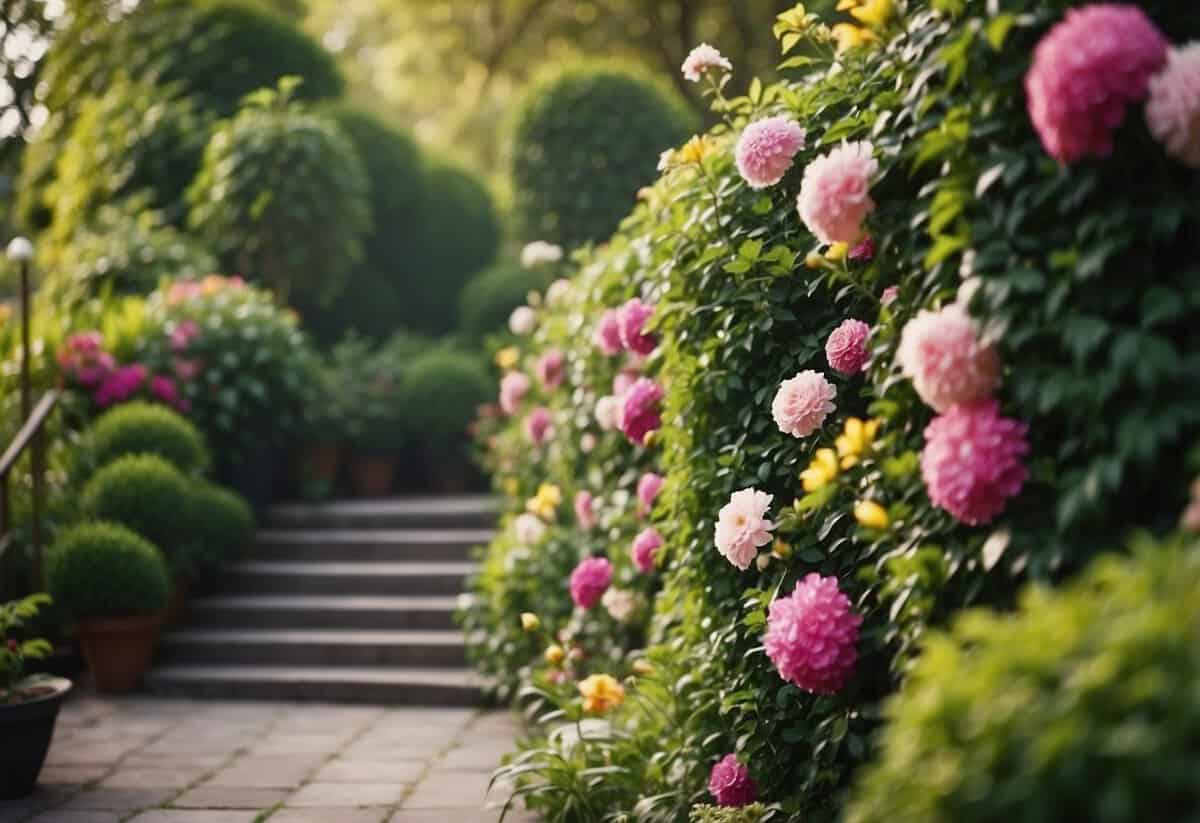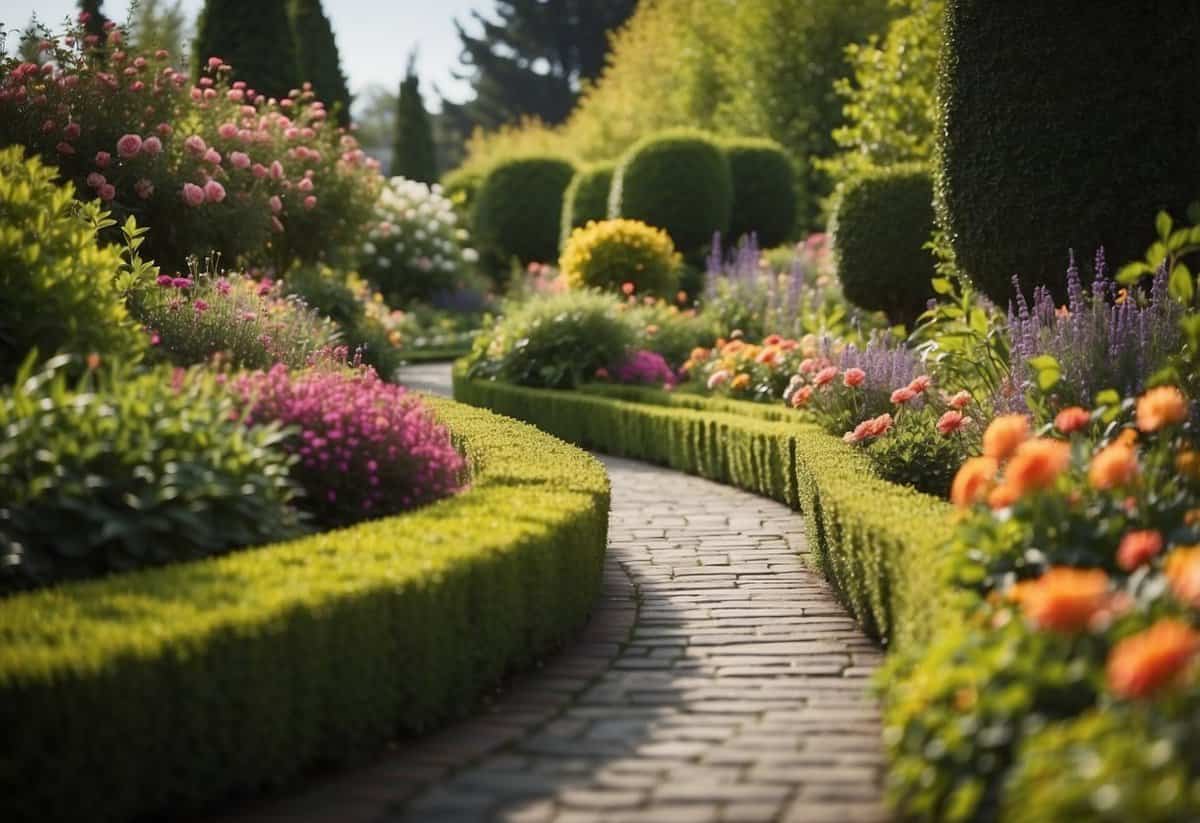Garden Hedge Ideas: Creative Ways to Transform Your Yard
Creating a beautiful garden with hedges can transform your outdoor space into a private sanctuary. Whether you’re looking to boost your curb appeal or create a natural barrier, hedges provide both aesthetic and functional benefits. They come in various shapes, sizes, and growth rates, making it easy to find the perfect fit for your garden.

What makes hedges so valuable is their ability to provide privacy while enhancing the look of your yard. From evergreens to flowering shrubs, you have many options to explore that can suit your style and climate. With some careful planning and the right choices, your garden can become a lush, green haven.
1) Boxwood Hedges

Boxwood hedges are a classic choice for any garden. They are known for their dense, evergreen foliage and versatility in landscaping. These plants can be pruned into various shapes, making them great for both formal and informal gardens.
Boxwoods are low-maintenance, which is perfect if you want a beautiful hedge without too much work. Plus, they provide a year-round green backdrop.
If you’re looking for options, consider the Green Mountain Boxwood. It grows 3 to 5 feet tall and is perfect for mid-sized hedges. For larger spaces, boxwoods can also create effective privacy barriers.
2) Yew Hedges

Yew hedges are a great choice if you want an evergreen option for your garden. These hedges are known for their dense foliage and ability to provide year-round privacy.
Yews, like the Taxus Baccata, can grow in various conditions. They thrive best in well-drained soil. To plant yew hedges, space them about 18 inches apart to allow room for growth.
Pruning yew hedges properly is essential. Trim only the sides until they reach the desired height. This helps the hedge grow denser and maintain its shape. For more details, check out this guide.
3) Privet Hedges

Privet hedges are a great choice for making your garden private. They are evergreen shrubs that can grow quickly, giving you a natural, green fence.
They are easy to plant and prune. Just dig a trench and space the shrubs about 12 inches apart.
Birds love the berries, but be careful because it can spread easily through seeds. For more tips, check out this guide to growing privet.
4) Holly Hedges

Holly hedges are a fantastic choice for adding privacy and beauty to your garden. These shrubs are evergreen, providing year-round greenery that makes your garden look vibrant even in winter.
Some types of holly, like the Burford holly, are ideal for warmer climates and can be shaped into dense, attractive hedgerows.
Another popular variety is the Sky Pencil holly, which grows tall and narrow, making it perfect for smaller spaces.
For small gardens, the Scallywag holly offers a compact, sturdy option that looks great in containers or tight spaces.
5) Laurel Hedges

Laurel hedges are a great choice for your garden. They have large, glossy green leaves that look beautiful year-round.
Cherry and bay laurels thrive in partial to full sun. They can tolerate some shade, but they grow best with plenty of sunlight.
To create a dense border, plant your laurels 2-3 feet apart. This spacing helps them fill in quickly and form a lush, green wall.
Cherry laurels even produce delicate white flowers in summer and red berries in winter, adding seasonal interest to your garden. Learn more about growing laurel hedges from this guide.
6) Cherry Laurel Hedges

Cherry laurel hedges are perfect if you want an evergreen option. Their glossy, green leaves create a dense screen. This makes them great for privacy.
These hedges are also quite hardy. They can withstand cold winters. Plus, they are robust and resilient.
Planting cherry laurels is easy. They thrive in both sun and partial shade conditions. Just ensure the soil is well-draining. For more tips on growing cherry laurel hedges, visit this guide.
7) Beech Hedges

Beech hedges are a great choice for your garden. They have wonderful foliage that stays on even in winter, giving your garden some color year-round. They are also known as European Beech or copper beech.
You can easily shape a beech hedge into a neat boundary. Trim it into an ‘A’ shape to ensure all parts get enough light. This helps it stay healthy and full.
By planting beech hedges, you add a natural screen to your garden and a touch of beauty.
8) Hornbeam Hedges

If you’re looking for a dense, lush hedge, hornbeam hedges are a great choice. They are known for their tightly-knit branches and rich green leaves.
Hornbeam hedges grow well in various soil types and can handle some shade. They can also tolerate pruning, making them perfect for shaping into neat, attractive borders.
For a beautiful garden, consider a hornbeam hedge for privacy and aesthetic appeal. Learn more about planting and caring for hornbeam hedges at Gardenista.
9) Escallonia Hedges

Escallonia hedges are a fantastic choice for your garden. They thrive in sunny spots and well-drained soil. You can grow them as a windbreak or border since they tolerate salt spray, making them ideal for coastal areas.
These hedges have glossy green leaves and beautiful flowers. The blooms range from white to shades of pink and red, adding vibrant color to your garden throughout the summer and autumn.
Escallonia grows quickly, about 25-45 cm per year, and can reach heights of 1-3 meters. It’s easy to maintain and provides year-round greenery. Learn more about growing an escallonia hedge.
10) Lavender Hedges

Lavender hedges can add beauty and fragrance to your garden. They have lush green foliage with vibrant purple blooms that make any space look stunning.
Lavender plants are easy to care for once they are established. They attract bees and other pollinators, which is great for your garden’s health.
When planting, choose a variety suitable for your climate. English lavender is a popular choice for its compact growth and winter hardiness. Make sure the root ball is level with the soil surface and water thoroughly.
Choosing the Right Hedge Plants

Picking the perfect plants for your hedge involves considering the benefits of evergreen versus deciduous plants and understanding your local climate. This will help ensure your hedge thrives year-round and meets your specific needs.
Evergreen vs. Deciduous Hedges
Evergreen hedges provide year-round privacy and greenery. Arborvitae and Boxwood are popular choices. Arborvitae, like the ‘Smaragd’ or ‘Emerald Green,’ maintains its shape with little upkeep and can grow up to 14 feet tall. Boxwood is ideal for smaller, formal hedges and requires regular trimming to keep its shape.
Deciduous hedges shed their leaves in winter but often provide beautiful flowers or vibrant fall colors. For example, Forsythia spectabilis makes a striking spring display with its yellow blooms and is well-suited for urban settings due to its toughness and adaptability to various soil types (Homes & Gardens).
Climate Considerations
Your local climate plays a crucial role in choosing hedge plants. For mild climates, Bigfoot™ cleyeras, with their glossy evergreen leaves, can grow 15-20 feet tall and make a dense, attractive hedge (Southern Living). They thrive in acidic to slightly acidic soils and prefer moderate temperatures.
In colder regions, plants like Arborvitae are hardy and can tolerate freezing temperatures. Conversely, if you live in a hot, dry climate, consider drought-tolerant species like Oleander or Cotoneaster, which can handle heat and lower water availability.
Choosing plants that match your climate ensures they remain healthy and require less maintenance.
Designing Your Garden Hedge

When designing your garden hedge, consider the shape and size of the hedge as well as how it integrates with existing landscape features. Both factors significantly impact the overall appearance and functionality of your garden.
Shape and Size Selection
Choosing the right shape and size for your hedge is crucial. Opt for formal shapes like squares or rectangles if you want a clean, structured look. These shapes are great for creating defined borders. For a softer, more natural appearance, go for informal shapes with gentle curves and varying heights.
Consider the growth habit of the plants you select. Some plants naturally grow tall and narrow, while others spread out. For easy maintenance, select plants that match your desired hedge size without needing constant trimming.
You might consider a small hedge at the front of a border to act as a foil to perennials. This not only adds structure but also provides a contrast to flowering plants. Be mindful of the mature size of the plants to prevent overcrowding.
Integrating with Existing Landscape
Your garden hedge should complement the existing elements of your landscape. If your garden has winding paths and a rustic feel, choose more informal hedge styles. For instance, mixed hedges that combine different plants can add both texture and diversity to your garden.
Think about how the hedge will interact with other plants and features. A mixed hedge with evergreen shrubs, flowering plants, and ornamental grasses can create a lush, vibrant look. This approach also attracts beneficial insects and birds, enhancing biodiversity.
Don’t forget about the functional aspects. Use hedges to create secluded seating areas or to block wind and add privacy. Design your hedge to flow with the natural contours of your landscape. This will help the hedge to feel like a natural part of your garden rather than an afterthought.
Maintenance Tips for Healthy Hedges

Keeping your hedges healthy and neat involves regular pruning and watching for pests and diseases. By following some simple tips, you can ensure your hedges thrive and add beauty to your garden.
Pruning Techniques
Pruning is vital for the health and shape of your hedges. You should start pruning when the plants are young to establish a good structure.
For a neat hedge, trim the top narrower than the base. This helps sunlight reach the lower branches, preventing them from dying off. Use sharp tools to make clean cuts, which heal faster and reduce disease risk. Hand pruners are ideal for small branches, while hedge shears work well for larger areas.
Tips:
- Prune in late winter or early spring for most hedges.
- Avoid heavy pruning during late autumn.
- Remove dead or diseased wood first.
Pest and Disease Control
Keeping an eye on your hedges for pests and diseases is essential. Common pests include aphids, spider mites, and scale insects. Regularly inspect your hedges and treat infestations early with appropriate pesticides or natural remedies like insecticidal soap.
Diseases like powdery mildew, rust, or leaf spot can affect hedge plants. To prevent these, ensure proper airflow by spacing plants correctly and avoiding overhead watering. If you notice signs of disease, remove and dispose of affected parts to stop the spread.
Tips:
- Use mulch to retain moisture and control weeds.
- Water at the base, not on the leaves, to avoid fungal infections.
- Choose disease-resistant plants if possible.







